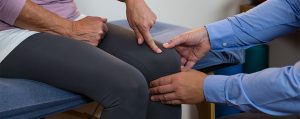5 Exercises For Runners With Ankle Pain
Everyone knows exercise is a key component to staying healthy. With nicer weather comes more outdoor activities, including running. Running produces a ground reaction force of 2.5 times the runner’s body weight, while walking produces only 1.2 times the runner’s body weight1. With the increased demand from ground reaction forces and the foot being the first to come in contact with the ground, ankle pain can be common in runners. So, what can we do to prevent injury, specifically to the ankle, with the increased demand required during running? Here are five exercises to improve and prevent ankle pain, specifically when running.
Tips from a PT: Maintaining Endurance During the Winter
Winter is when many of us hibernate inside to watch Netflix and make sweet treats in the kitchen. But if you are someone looking to build your endurance for later in the year – such as for a race or general fitness – you do not want to take these winter months off before resuming activity in the spring. If you are usually active in the other three seasons of the year, it would greatly behoove you to maintain regular activity in the winter months. Winter is the perfect time for endurance athletes to take it a little easier and focus on building and maintaining their base for a more efficient aerobic system. Here are some tips to consider during the cold months:
Recovering From 26.2
Congratulations on finishing the marathon – what an accomplishment! 26.2 miles is an incredible feat by the human body and mind. We know that after the race, our body and mind can be in a state of disarray. Not only is 26.2 taxing on our legs, but it takes its toll on our blood flow, digestion, and our ability to function in the coming hours, days, and weeks.
Why Do Runners Get Shin Splints?
If you’ve ever felt a nagging pain or tingling along the inside of your shinbone (tibia), you may have what’s known as shin splints. The good news is with proper recovery and tips from your physical therapist; this injury doesn’t have to keep you from doing what you love. Read below to learn more about shin splints and how they’re treated.
4 Common Causes of Hip Pain in Runners
Running is a common form of exercise that people of all ages can and do participate in. Mobility, strengthening, running mechanics, and stabilization are critical factors to consider when beginning a running program. Without proper mobility, strengthening, and stabilization, one can develop hip pain.
Hip pain is very common in runners, can vary from the front, side, or back of the hip, and has many different causes. Hip pain specifically could be caused by poor movement patterns and weakness in the hip, but also could be caused by poor core strength or an old injury to the low back, knee, or even ankle. Below you will find the four most common causes of hip pain and what you can do about it.
5 Tips to Prevent Common Running Injuries
Running has become an increasingly popular activity for exercise among people of all ages. In fact, 60 million people within the United States participate in some form of running activity each year. People participate in running activities for numerous reasons including: improving fitness, weight concerns, running a race/competition, staying healthy, and having fun. Running for 5 – 10 minutes per day has shown to decrease the risk of death and cardiovascular disease. Running less than 50 minutes per week has also shown to reduce the risk of death from heart disease when compared to individuals who don’t participate in running at all. While running has many benefits, about 50% of people get injured each year from running. Running injuries can be caused by poor running technique, reduced strength and flexibility, improper footwear, as well as overuse.
4 Tips to Prevent Achilles Pain or Injury
Achilles pain or injury can prevent itself in the form of tendinopathy (i.e. tendinitis or tendinosis), or the more critical Achilles tendon tear or rupture. The Achilles tendon is the tendon to the gastroc and soleus, which together are known as the calf muscles. The role of a tendon is to transfer the force from the contracting muscle to the intended joint of movement. Together these muscles plantarflex the ankle joint, or point the foot downwards. This action creates the force needed to push the ground away and help propel the body forwards (or upwards) when we are walking, running, or jumping. The Achilles tendon is the strongest tendon in the body, and the gastroc and soleus are the primary ankle plantar flexor muscles.
The Mental & Physical Sides of Running: What Keeps Me Going
I don’t have to be the first to tell you that this has been a tough year for everyone emotionally, mentally and physically. Sticking to a healthy routine has never been more important. Throughout the last year, running has always been an outlet for me. Through tough, lonely, and cold days where it was an effort to even get out of the house, running has always put my mind and body at ease, providing stress relief and happiness, even if for a short period of time.

